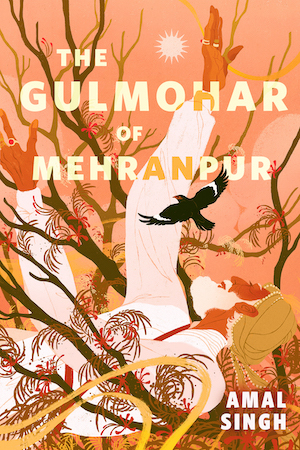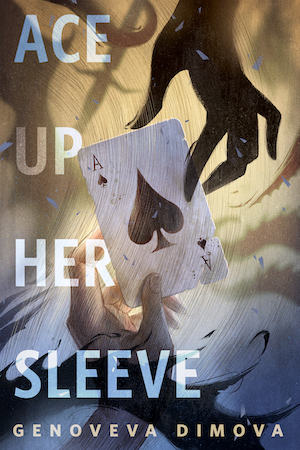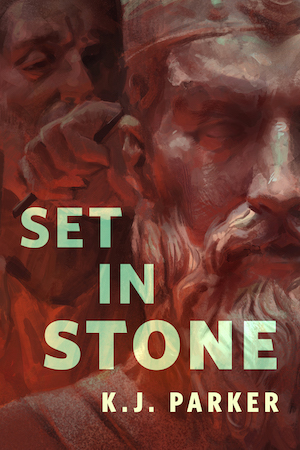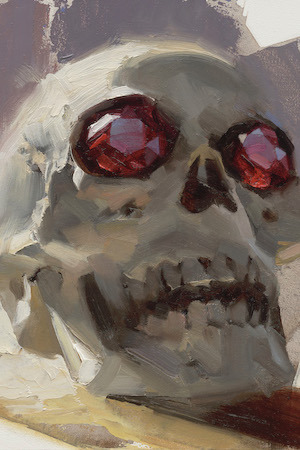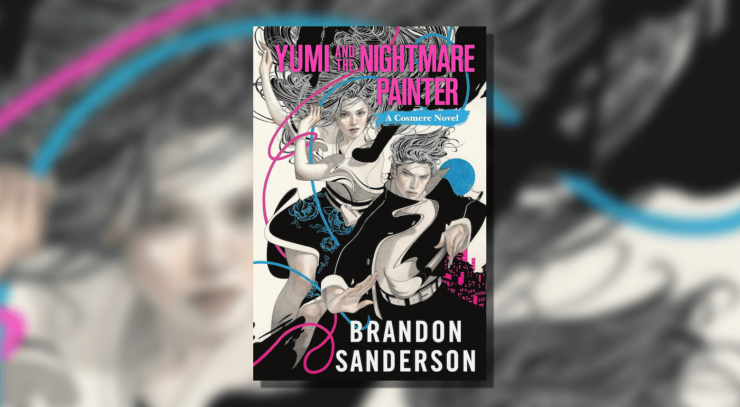Last year, I wrote an essay about Sazed the Keeper from Brandon Sanderson’s Mistborn, in which I argued how everything you create matters because someone out there is looking for that very book you’re writing or the song you’re composing. I still believe this to be true, but I also believe that there are times when we must look beyond the utility of our art and make things because we want to.
While many see Sanderson’s Yumi and the Nightmare Painter as his response to ChatGPT and the negative impacts of AI on artists (even though the book was written before the chatbot’s release), what I saw in the book, instead, were two artists learning to separate art from utility.
Too often we look to usefulness and service to justify our art—this poster will inspire climate action, this book will help people build better relationships, this movie with these tropes will become a hit, these aesthetic product videos will get us more sales, and so on and so forth. In our current side-hustle, personal brand-driven world, everything is done with some (capitalistic) goal in mind. (And tools like ChatGPT became popular/hated for this very reason.) As a result, eventually, inevitably, many of us find that baking cakes or drawing portraits or whatever we’re creating is no longer fun or satisfying.
As we see in the book: Nikaro—Painter—devoted his entire life to his art, secretly sketching even during classes, and became the best in his year. He dreamed of being able to do something for others and derived joy from sharing his art with his friends. Then, unfortunately, when he started working as a nightmare painter, he found that the work didn’t live up to the expectations school had given him. It was “just a job.” People took him for granted and complained if he failed, so much so that when the father of the boy he saves at the beginning thanks Painter, he’s actually surprised.
At work, he paints nothing but bamboo because it’s efficient. He doesn’t feel the need to make anything else. But when he paints the frightened boy’s mother to ward off the almost-stable nightmare, he finds a little of the joy of painting returning to him. He feels it again when he sketches the residents of Yumi’s village, allowing himself to look beyond the utility of his skills—painting is his meditation.
Yet the hold of efficiency is strong on him. For a moment, when he starts teaching Yumi, he loses himself in explaining what it means to be an artist, but then immediately snaps back and instead shows her how to paint bamboo, focused—again—on simply getting the job done.
Yumi, on the other hand, is reminded repeatedly of the honor she’s been given, of the fact that she’s a “resource.” She gets no compliments and feels guilty for wanting them. While Nikaro asks Design if what he does is important, Yumi knows her art is useful, yet she doesn’t allow herself to feel proud of her creations because stacking stones is supposed to be a service, not a source of joy. Despite being the best at her art and putting thought and creativity into each of her intricate stacks, she tells Painter she’s “merely a vessel” and not an artist.
Both she and Nikaro have attached their self-worth to their art. Yumi is shocked when Tojin tells her he doesn’t build his muscles in order to accomplish something; the bodybuilding itself is an accomplishment. When Painter makes the villagers’ portraits, Yumi asks him why he would paint something that wouldn’t help him fight nightmares.
As I read the book, I wanted to tell them both that not everything we do has to be useful, a lesson that took me a long time to learn and which I still sometimes forget. Deep down, Nikaro knows it too. His training was “very pragmatic,” teaching him how to control his thoughts. Yet when Yumi tries to teach him how to stack rocks with precision, he argues against her approach. “Art is about feelings and emotion. It’s about letting them escape, so they can be shared. It’s about capturing a truth about yourself. Like you’re ripping a hole in your chest and exposing your soul,” he says, even though every day at work he pretends to be the lone hero, nonchalant, unaffected by what others think of him.
Yumi, too, feels better when she creates her spiraling towers of stones. One of the first things she does when she finds herself in Painter’s world is to build stacks of bowls and plates to calm down, never considering that she’s doing it for herself—any suggestion of that sort would make her guilty about being selfish.
She finds some freedom from the trap of utility when she has the idea to stack stones by copying their souls. No one can see her in her world. She’s not performing a role; the stacking won’t attract any spirits. But those things don’t matter much, she realizes. She’d missed stacking because it was her art. Even Nikaro enjoys it because of how long it had been since he’d made something just for the sake of it, for the sheer joy of creating.
Where discussion of creating art is concerned, the role of pain comes up more often than not. Modern culture tends to do a very good job of romanticizing life’s difficulties, especially when faced by an artist. Growing up, I loved reading nonfiction and dreamt of writing beautiful essays of my own, yet the more stuff I read the more I noticed how often essays spoke about death, abuse, trauma, and grief. Bereft of such pain (gratefully), my younger self took the prevalence of these themes to mean that I wasn’t equipped to write meaningful nonfiction. Determined to make art, however, a few years later I embraced the opposite perspective with stubbornness—I’d become an essayist by writing about the good things in life, because I’d learned that art can come from sources other than pain too.
Answering a fan question, Sanderson once noted how we have this narrative that “sadness is artistic.” Very rarely will the word artist conjure the image of a happy person. Nikaro explains this to Yumi when the show they’re watching doesn’t end on a happy note—making something sad means “people find it more realistic.” She doesn’t like the idea—if you’re an artist, why make something depressing on purpose?
After all, Nikaro and Yumi create art when they’re happy too. Painter’s portfolio, for example, is filled with masterpieces he’d made when he was training with his group of friends—the happiest time of his life. The mural he paints on the warehouse wall at the end—his greatest work—depicts the exhilarating moments he shared with Yumi, soaring on a tree high up in the air, running from the scholars. Her gift to him is a painting of them holding their hands as they watched the carnival and the city spread below them.
The spirits of Yumi’s world don’t demand pain or suffering either. What attracts them, in addition to “the mixing of math and art,” as Design explains, is “the human aspect—the concentration, the satisfaction, the emotion.” Not negative emotion. Just emotion. During the Battle of Kilahito, seeing and painting the humanness of the nightmares is what frees the souls trapped in the shroud.
Creating art out of pain is cathartic—and to many, essential— but despite the romanticized narrative that our culture and media often celebrates, pain isn’t required to make art. (At the same time, not all suffering results in art. As author Kate Jacobs wrote in Comfort Food, “Sometimes suffering is just suffering […] It doesn’t make you stronger. It doesn’t build character. It only hurts.”)
In addition to Sanderson’s rejection of the “sadness is artistic” narrative, I was also glad to see him address the belief that “true artists create, even if nobody is watching,” a perspective that causes Painter to speak of his passion in the past tense. He thinks he’s not a true artist because he craves an audience. But art is meant to be shared; it gains meaning from those who react and engage with it. It’s “meaningless without those to admire it,” Hoid says, rejecting the argument that true artists don’t care for what others think of their creations. Art is made by people for people, regardless of how they’re separated in time and space.
This was art. Something the machine, however capable in the technical details, could never understand. Because art is, and always has been, about what it does to us. To the one shaping it and the one experiencing it.
For Yumi, on the transcendent day, she was both. Artist and audience.
—Yumi and the Nightmare Painter, Chapter 41
Hoid repeatedly argues that things have the value that we assign them. I see it as a call to let go of expectations about the things you make, wondering if they’re art or not—or if they have a use. Nikaro realizes this towards the end when he tells Yumi that art is about creation. The mere process of making something from nothing is meaningful. Art serves a purpose even as it is being created, because that process is what brings joy. Everything else that results after the creation—communication, connection, praise, money—is a bonus. The effect starts from us—inside us—and then reaches others when we share our work with them.
Over the course of the book, Painter becomes an audience for her work, observing her process, and can see that there’s a difference between the stacks Yumi makes and the stacks the machine makes. They look the same, but, as he explains, “Art is about intent […] I don’t care how well a machine piles rocks. The fact that you do it is what matters to me.” This is an echo of something Yumi says earlier to Painter, trying to get him interested in his art again:
“It matters,” she said, “that you’ve stopped painting. It doesn’t matter that you didn’t get accepted by the Dreamwatch.”
—Yumi and the Nightmare Painter, Chapter 28
In the blogosphere are many people whose writing I love (these two, for example), writers who explain that they blog because they love doing so and not because they seek an audience. Social media tends to make us all hungry for validation and personal blogging can be a way to fight against algorithms that make us greedy for higher metrics. Feeling disgusted by how much time I was spending online, staring at various screens, I readily internalized the idea that wanting an audience for my writing—especially when I didn’t have anyone to share my work with in my personal circles—was wrong. That to create for oneself was a virtue, while creating to share my work with others wasn’t.
But after trying to write only for myself, denying myself the joy of blogging online in an attempt to prove (to whom, really?) that I was above the need to have my work enjoyed by others, I’ve come to realize that while being dependent on external validation to feel worthy is a problem, seeking an audience for our art is a reflection of our need to connect—not a sign of vanity. It doesn’t matter if that audience includes friends, strangers, or only a single person, as Yumi was for Nikaro when he painted his warehouse mural. It matters that there is someone. It matters that we create. Because what’s worse is not creating, as Yumi says. What’s worse is the world not having any art in it at all, because we thought our art wasn’t useful or that we were vain and selfish and not, instead, human.
Buy the Book
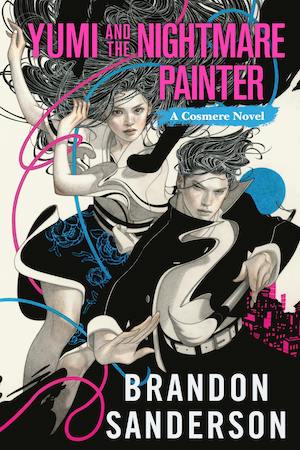

Yumi and the Nightmare Painter


